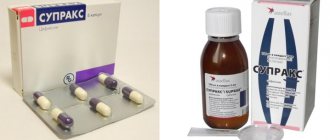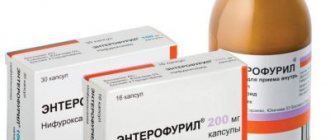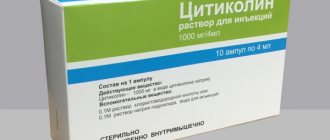Augmentin is a semi-synthetic broad-spectrum antibiotic with a good antibacterial effect.
The main substance of the drug is amoxicillin, active against gram-positive and gram-negative microorganisms, as well as clavulanic acid.
The drug is presented in the form of tablets and powder for preparing a suspension for internal use, as well as powder for diluting an injection solution. The exact dosage of the dosage form and suitable analogues are selected by the doctor individually for each patient.
The drug is recommended for patients with diseases of bacterial etiology that affect the respiratory tract and ENT organs, skin and subcutaneous tissue, the genitourinary system, as well as for the elimination of sepsis, osteomyelitis, phlegmon and peritonitis.
pharmachologic effect
Manufacturer: GlaxoSmithKline plc (UK)
Release form: tablets, powder for solution for intravenous administration, suspension
Active ingredient: amoxicillin, clavulanic acid
Analogs: Amoxiclav, Azithromycin, Flemoxin
Augmentin is an antibacterial agent, active against many strains of gram (+) and gram (-) microorganisms. The drug has the ability to penetrate bacterial cell walls and cause inactivation of enzymes, which leads to the death of pathogens.
List of cheaper structural analogues
The list of exact structural analogues of Augmentin includes all antibacterial drugs from the group of protected penicillins, containing amoxicillin + clavulanic acid.
There are more than forty items in total, but they are more expensive.
More budget-friendly Russian-made generics in tablets are:
- “Amosin” – from 30 rubles.
- “Verklav” – from 65 rubles.
- “Arlet” – from 110 rubles.
- “Ecoball” – from 120 rubles.
- “Ecoclave” – from 160 rubles.
Inexpensive Ukrainian analogues in tablet form: “A-Clav Pharmex”, “Amoxi-Apo-Clav”, “Amoxil-K”, “Amoxicillin + Clavulanic Acid-Pharmex”, “Theraclave-Zdorovye”.
Cheap foreign substitute: “Amoxiclav” - from 123 rubles. Country of origin: Slovenia.
Indications for use of Augmentin
Augmentin is prescribed for infections caused by pathogenic bacteria sensitive to the antibiotic:
- For infectious processes of the skin and soft tissues.
- Diseases of the respiratory system (bronchitis, pneumonia, empyema, lung abscess).
- Infections of the genitourinary system (cystitis, urethritis, pyelonephritis, gonorrhea, endometritis).
- Diseases of ENT organs (tonsillitis, sinusitis, otitis media).
- Infections of the musculoskeletal system (osteomyelitis).
The antibiotic is used for septic conditions, peritonitis, and also as a preventive therapy after surgical and diagnostic interventions of various profiles.
Buy Augmentin film-coated tablets 500mg+125mg No. 14 in pharmacies
Augmentin Buy Augmentin in DOSAGE FORMS film- coated tablets 500mg/125mg film-coated tablets 500mg+125mg
MANUFACTURERS Smithkline Beacham (Great Britain) Smithkline Beacham PLC (Great Britain)
GROUP Combined antimicrobial agents
COMPOSITION Active substance: amoxicillin + clavulanic acid.
INTERNATIONAL NON-PROPENTED NAME Amoxicillin + Clavulanic acid
SYNONYMS Amoxiclav, Amoxiclav Quiktab, Arlet, Augmentin EU, Augmentin SR, Clamosar, Medoclav, Panclave, Ranclave, Rapiclav, Sinulox, Sinulox RTU, Flemoclav Solutab, Ecoclave
PHARMACOLOGICAL ACTION Broad spectrum antibacterial. Blocks the synthesis of peptidoglycan of the membrane of microbial cells (amoxicillin), inhibits beta-lactamases (clavulanic acid). Clavulanic acid forms a stable inactivated complex with these enzymes and protects amoxicillin from the loss of antibacterial activity caused by the production of beta-lactamases by the main pathogens and opportunistic microorganisms. Active against gram-positive aerobes: Streptococcus pneumoniae, S.pyogenes, S.viridans, S.bovis, Staphylococcus aureus (except methicillin-resistant strains), S.epidermidis (except methicillin-resistant strains), Listeria spp., Enterococcus spp. Gram-negative aerobes: Bordetella pertussis, Brucella spp., Campylobacter jejuni, E.coli, Gardnerella vaginalis, H.influenzae, H.ducreyi, Klebsiella spp., Moraxella catarrhalis, N.gonorrhoeae, N.meningitidis, Pasteurella multocida, Proteus spp., Salmonella spp., Shigella spp., Vibrio cholerae, Yersinia enterocolitica. Anaerobes: Peptococcus spp., Peptostreptococcus spp., Clostridium spp., Bacteroides spp., Actinomyces israelii. Rapidly absorbed after oral administration (food intake does not affect absorption). The maximum concentration is reached 1 hour after administration. The maximum plasma concentration after a bolus injection of 1.2 g is 105.4 mg/l (for amoxicillin) and 28.5 mg/l (for clavulanic acid). It has a large volume of distribution - high concentrations are found in body fluids and tissues (lungs, pleural, peritoneal, synovial fluid, tonsils, bronchial secretions, prostate gland, peritoneal abscess, muscle tissue, adipose tissue, paranasal sinus secretions, middle ear, etc. .). Peak concentrations in body fluids are observed 1 hour after peak plasma concentrations are reached. Does not pass through the BBB when the meninges are not inflamed, passes through the placental barrier and penetrates into breast milk in trace concentrations. Weakly binds to plasma proteins. Amoxicillin is partially metabolized, clavulanic acid undergoes intensive metabolism. Amoxicillin is excreted by the kidneys almost unchanged by tubular secretion and glomerular filtration; clavulanic acid - by glomerular filtration, partly in the form of metabolites. Small amounts are excreted by the intestines and lungs. The half-life is 1-1.5 hours, with severe renal failure it increases to 7.5 (for amoxicillin) and 4.5 hours (for clavulanic acid). It is removed during hemodialysis, and slightly - during peritoneal dialysis.
INDICATIONS FOR USE Infectious diseases of the upper (acute and chronic sinusitis, acute and chronic otitis media, retropharyngeal abscess, tonsilopharyngitis) and lower respiratory tract (acute and chronic bronchitis, pneumonia, pleural empyema); urinary tract infections (including cystitis, urethritis, pyelonephritis), gynecological infections (including salpingitis, salpingoophoritis, endometritis, septic abortion, pelvioperitonitis); biliary tract (cholecystitis, cholangitis), bone and connective tissue (including chronic osteomyelitis), skin and soft tissue (phlegmon, wound infection), odontogenic infections (periodontitis); sexually transmitted infections (gonorrhea, chancroid).
CONTRAINDICATIONS Hypersensitivity; history of allergic reactions to antibiotics of the penicillin and cephalosporin group; cholestatic jaundice, hepatitis caused by taking penicillin antibiotics (in history); liver failure; infectious mononucleosis, lymphocytic leukemia. Use during pregnancy and breastfeeding: possible if the expected effect of therapy exceeds the potential risk to the fetus. Breastfeeding should be stopped during treatment.
SIDE EFFECTS In most cases, side effects are weak and transient, most often affecting the gastrointestinal tract: loss of appetite, nausea, vomiting, diarrhea. Possible development of superinfection, stomatitis, vaginitis; in rare cases - pseudomembranous colitis with severe diarrhea. Allergic reactions may occur: itching, skin rashes; in sensitive patients, immediate hypersensitivity reactions may develop (angioedema, bronchospasm, rarely - anaphylactic shock). It is extremely rare that a transient increase in the level of transaminases in the blood plasma can be observed. There are isolated reports of the occurrence of cholestatic jaundice, hepatitis, and liver dysfunction.
INTERACTION When used simultaneously with methotrexate, the toxicity of methotrexate increases, with allopurinol - the incidence of exanthema, and with anticoagulants - the prothrombin time is prolonged. Reduces the effectiveness of oral contraceptives. Concomitant use with disulfiram should be avoided. The effectiveness of Amoxiclav is weakened by combination with bacteriostatic antibiotics (macrolides, tetracyclines), combination with rifampicin is antagonistic. Probenecid reduces the excretion of amoxicillin, increasing its serum concentration. Pharmaceutically incompatible with solutions containing blood, proteins, lipids, glucose, dextran, bicarbonate. Do not mix in a syringe or infusion bottle with other drugs. Incompatible with aminoglycosides.
DOSAGE AND ADMINISTRATION The dose of the drug depends on age, body weight and kidney function.
OVERDOSE Symptoms: in most cases nausea, diarrhea, vomiting, possible agitation, insomnia, dizziness, and in some cases seizures. There are no reports of deaths or life-threatening side effects. Treatment: symptomatic, in case of recent use (less than 4 hours), remove the drug from the gastrointestinal tract (gastric lavage, taking activated charcoal to reduce absorption), hemodialysis is effective.
SPECIAL INSTRUCTIONS Prescribe with caution to patients prone to allergic reactions to cephalosporins and other beta-lactam antibiotics (risk of cross-sensitivity), with severe impairment of liver and kidney function (dosage regimen adjustment is necessary). High concentrations give a false positive reaction for glucose in urine when using Benedict's reagent or Felling's solution (it is recommended to use enzymatic reactions with glucose oxidase).
STORAGE CONDITIONS List B. At room temperature.
Augmentin - instructions for use
According to the instructions for use of Augmentin, the dosage of the medication is calculated individually, taking into account age, weight, and severity of the infection. The standard dose of the drug is: 1 tablet of Augmentin 500 mg + 125 mg 2-3 times a day, for 2 weeks.
According to indications, it is possible to prescribe the medication according to a stepwise scheme, that is, the initial intravenous administration of the drug is subsequently replaced by taking tablets.
How to take Augmentin: before or after meals
The antibiotic Augmentin should be taken immediately before meals or with meals. The tablet is swallowed whole and washed down with a sufficient amount of water. For children, the medication is prescribed in the form of a suspension from 2 months of age.
Dosages
The selection of the optimal dose depends on the dosage form, which is prescribed taking into account the patient’s age and the nature of the disease.
Dosage table
| Release form | Dose and frequency of administration |
| Suspension (125, 200, 400). |
|
| Tablets (for patients over 12 years of age, weighing at least 40 kg). |
|
| Solution for injection (adults and children over 12 years of age). |
|
| Solution for injection (3 months-12 years). |
|
1 tablet of Augmentin 1000 mg (875+125 mg) is equivalent to 11 ml of suspension (400/57 mg).
Augmentin's analogues
The pharmacy chain has a large number of Augmentin substitutes with equivalent indications and therapeutic effects from domestic and foreign manufacturers. These medications are sold in the form of:
- combination drugs;
- synonyms;
- generics.
A wide range of substitute medications allows doctors to cope with infections of any severity as effectively as possible.
Prices for Augmentin analogues vary widely. The pharmaceutical market is represented by domestic and foreign manufacturers.
Table of Augmentin analogs with price and country of origin.
| Analogue | Cost in rubles | Manufacturer country |
| Augmentin | 120-250 | Great Britain |
| Amoxiclav | 80-450 | Austria |
| Azithromycin | 70-150 | Russia |
| Flemoxin | 250-500 | Netherlands |
| Sumamed | 120-450 | Croatia |
| Amoxicillin | 50-100 | Serbia |
| Ceftriaxone | 20-50 | Russia |
| Suprax | 500-850 | Italy |
| Levofloxacin | 150-1200 | Russia |
| Ampicillin | 50-1700 | Russia |
You can buy analogues of Augmentin cheaper or more expensive. Their cost does not affect the result of treatment, but depends on the manufacturer and the composition of the ingredients.
What else can replace Augmentin for an adult, what analogues? You can supplement the list of antibiotics with the following medications:
- Zinnat;
- Tavanik;
- Vilprafkn;
- Klacid;
- Tsifran;
- Biseptol;
- Clarithromycin;
- Tsiprolet;
- Clavamitin;
- Flemoklab solutab;
- Amoxiclav.
Among the many analogues of Augmentin, there are the latest generation medications with a wide spectrum of action and high activity against bacterial pathogens.
How to take Augmentin?
Note!
Augmentin should be taken strictly as prescribed by a doctor, since the causative agent of a bacterial infection can be various bacteria, and the appropriate treatment is determined by the doctor only after a thorough examination of the patient. Also, self-medication with Augmentin can lead to the development of antibiotic resistance and with further use of this drug it may turn out to be completely ineffective.
Augmentin works best when taken immediately before meals.
Augmentin must be taken every 12 hours. That is, one dose per day is enough (for example, every morning).
Augmentin tablets must be taken orally, whole, with a sufficient amount of water.
Before using Augmentin in the form of an oral suspension, shake the bottle thoroughly. When measuring the dose, you must use only the measuring container that comes with this dosage form. Do not use ordinary tableware, as deviations in dosage accuracy may occur.
Prepare the suspension during dosing as follows:
- tap the bottle until all the powder flows freely;
- add about ⅔ of the total amount of water and shake vigorously to suspend (mix until smooth) the powder;
- add the rest of the water and shake the bottle again;
- after which the suspension is ready for use.
Use this medication for the entire prescribed period, even if your symptoms improve quickly. Skipping doses may increase your risk of getting a drug-resistant infection.
Note!
Augmentin, which is an antibiotic, is absolutely ineffective for treating viral infections, so using it for influenza or ARVI is completely irrational. Its use takes place only if the viral disease is complicated and a bacterial infection (for example, pneumonia) is involved. But you should definitely remember that such a prescription must be determined by a doctor.
Augmentin tablets should be stored at normal room temperature, in a dry place.
Augmentin suspension must be stored in the refrigerator, it cannot be frozen, the maximum permissible value is 2°C. Once opened, the bottle should be stored for no longer than 10 days.
Augmentin or Amoxiclav - which is better for an adult, what is the difference
Manufacturer: LEK D. D. (Slovenia)
Release form: tablets
Active ingredient: amoxicillin, clavulanic acid
Both medications have the same active substances and an equivalent mechanism of action. The difference between the drugs lies in the auxiliary ingredients, of which Amoxiclav has more, which can provoke an unwanted allergic reaction.
Augmentin has fewer side effects, and it will be best for children, since the medication is gentler and is approved for use from 3 months. It will be the best for bronchitis and pneumonia for adults and children, as it is safer, well tolerated and can be prescribed for a long time (up to 2 weeks).
Amoxiclav is preferably used for angina, since the drug quickly, within a short time (5–7 days), relieves pathological symptoms.
Side effects
When using any dosage form, the development of undesirable side reactions is possible:
- Candidiasis of the skin and mucous membranes.
- Leukopenia, hemolytic anemia, prolongation of bleeding.
- Quincke's edema, vasculitis.
- Dizziness, migraines, hyperactivity, seizures, sleep disturbances, increased arousal, anxiety.
- Stool liquefaction, nausea, vomiting, colitis, gastritis, stomatitis, discoloration of tooth enamel.
- Hepatitis, jaundice, increased bilirubin.
- Rash, itching, urticaria, erythema, dermatitis, pustulosis.
Undesirable reactions from the urinary organs are also possible.
Augmentin or Azithromycin - which is better for pneumonia and bronchitis
Manufacturer: JSC VERTEKS (Russia)
Release form: capsules
Active ingredient: azithromycin
Both drugs have antibacterial activity, but have a different mechanism of action. Azithromycin belongs to the group of macrolides and is the best in the treatment of bronchitis and pneumonia.
The analogue is not excreted from the body for a long time, which creates its high saturation in the blood plasma. The medication successfully relieves pathological symptoms of pneumonia caused by viral etiology.
Consequences of an overdose of Augmentin
As a result of an overdose of Augmentin, adverse symptoms occur, which can subsequently cause consequences for various organs and systems of our body:
- dehydration and exhaustion of the body;
- renal failure;
- impaired liver function with the possible appearance of jaundice.
With prolonged overdose of this medication, other malfunctions of the body may occur. Therefore, when the first symptoms of a possible overdose of Augmentin appear, it is necessary to consult a doctor to eliminate them as quickly as possible.
Augmentin or Flemoxin Solutab – which is better?
Manufacturer: Astellas Pharma Europe BV (Netherlands)
Release form: tablets
Active ingredient: amoxicillin
Flemoxin Solutab and Augmentin contain the same active ingredient. But Augmentin is supplemented with 1 additional active ingredient - clavulanic acid, which makes it a stronger and better antibiotic in the fight against bacterial infection.
Thanks to the combination of 2 active substances, drug therapy allows you to quickly relieve pathological symptoms and reduce the treatment time for infectious diseases.
The principle of selecting a substitute drug
First of all, it may be necessary to change the medicine for economic reasons. Everything is simple here: choose a cheaper analogue that completely copies the composition of Augmentin.
The original antibiotic belongs to the middle price category and its cost is:
- from 260 rub. for tablets;
- from 140 rub. for the suspension.
According to medical statistics, allergies to clavulanic acid occur in more than 8% of the population.
In this case, a medicine is selected that also contains amoxicillin, but with other beta-lactamase inhibitors (sulbactam and tazobactam). Or a single-component antibiotic, only with amoxicillin (for example Flemoxin-Solutab or Azithromycin).
However, the latter is permissible only when the pathogen is not aggressive towards this active substance.
It is not uncommon for a patient to be allergic to amoxicillin itself. In this situation, you will need an antibiotic from a different pharmacological group - for example, the macrolide Suprax.
Augmentin or Sumamed – which is better?
Manufacturer: PLIVA HRVATSKA D.O.O.
(Croatia) Release form: tablets, capsules, powder for suspension
Active ingredient: azithromycin
Both medications have different active ingredients, but an equivalent therapeutic effect. Sumamed will be the best for angina, since only 3 tablets are required per course of treatment. The analogue, after taking it, remains in the body for another 3 days, which makes it possible to reduce or completely eliminate the symptoms of the disease.
For children, the analogue of Augmentin in suspension Sumamed is successfully used to treat bronchitis, otitis, and sore throat.
What you need to know before you start taking Augmentin
You should not use Augmentin if you are allergic to it or if you have a history of an allergic reaction to a group of antibiotics called cephalosporins. Since penicillins quite often cause an allergic reaction up to the appearance of anaphylactic shock (complicated immediate high sensitivity to the allergen). Penillins and cephalosporins have similar chemical structures, and therefore it is expected that the latter may also cause allergies.
You should also stop taking Augmentin and choose an alternative treatment if you have conditions and contraindications as:
- severe kidney disease (or if you are on dialysis);
- problems with liver function (or if there was a history of jaundice);
- mononucleosis (a viral infection characterized by damage to the lymphatic organs);
- phenylketonuria (a disorder of the biochemical reaction in the body, which is associated with the accumulation of the amino acid phenylalanine in various organs and tissues, which can cause damage to the central nervous system) - powders for the preparation of oral suspension may contain phenylalanine, which may result in its excess, which is dangerous for this type diseases.
Augmentin may reduce the effectiveness of oral contraceptives - this is worth considering if you are undergoing treatment with Augmentin and are taking contraceptives and you are not planning a pregnancy.
If you are pregnant or your child is breastfed and you have any disease of bacterial origin, before using Augmentin, be sure to consult your doctor about prescribing the correct treatment in such cases.
Augmentin or Amoxicillin – which is better for adults, what is the difference
Manufacturer: JSC BIOCHIMIC (Russia)
Release form: tablets, capsules
Active ingredient: amoxicillin
Antibiotics of the penicillin group have the same active substance and mechanism of action. The difference between medications can be traced in the composition of additional ingredients. The analogue does not contain glucose and can be used by patients with diabetes.
Augmentin has an additional active component, which makes it superior in the treatment of diseases in adults caused by an unknown pathogen.
Combined substitutes with beta-lactamase inhibitors
In addition to clavulanic acid, beta-lactamase inhibitors include sulbactam and tazobactam.
Combined preparations containing the following substances:
- Ampicillin + Sulbactam OJSC Kraspharma from 130 rub.
- Cephtractam from 30 rubles/ampoule.
- Flemoklav solutab from 231 rub.
- Cefoperazone and Sulbactam Jodas from 2100 rub.
- Tazocin from 6900 rub.
- Piperocilin-tazobactam from RUB 1,351.
If you need to select a replacement, it is recommended to first consult with your doctor, since all antibiotics are available in pharmacies with a prescription.
Ceftriaxone
Manufacturer: ZAO LEKKO (Russia)
Release form: powder for the preparation of a solution for parenteral administration
Active ingredient: ceftriaxone
The medication is a 3rd generation cephalosporin antibiotic. Ceftriaxone has a broad spectrum of action and activity against a wide range of strains of gram-positive and gram-negative bacteria.
The Augmentin analogue inhibits the biosynthesis of the bacterial cell wall. The drug actively penetrates the tissues and fluids of the body, exerting a bactericidal effect.
Interaction of Augmentin with other drugs and substances
Augmentin may enter into general reactions with drugs from other pharmacological groups or with other groups of antibiotics when used simultaneously, as a result of which this may negatively affect the body or weaken the effect of Augmentin.
List of some drugs that interact with Augmentin :
- Allopurinol (a drug for the treatment of gout) - an allergic reaction to Augmentin may increase;
- Probenecid (anti-gout drug) - slows down the excretion of Augmentin from the body;
- anticoagulants (preventing blood clotting) - Augmentin enhances their pharmacodynamics (pharmacological effect).
These are just the most common interactions of Augmentin with other drugs. To find out more, you should consult your doctor and carefully read the official instructions for the drug.
Suprax
Manufacturer: Menarini Manufacturing Logis (Italy)
Release form: tablets
Active ingredient: cefixime
Suprax is a semi-synthetic cephalosporin antibiotic. This analogue of Augmentin in tablets has a wide spectrum of action and is a 3rd generation antibiotic.
The medication has a bactericidal effect due to inhibition of the synthesis of the cell membrane of the bacterial pathogen. The drug has a long half-life, which allows you to take the medicine once a day.
Symptoms of Augmentin overdose
If the dosage regimen is not followed and the doctor’s recommendations are ignored, an overdose of this drug may occur, which manifests itself in the form of the following symptoms:
- acute diarrhea;
- water-electrolyte imbalance;
- the presence of salts in urine (crystalluria);
- liver dysfunction.
If you have taken Augmentin in too high a dose and you experience one or more of the above symptoms, you should consult a doctor for symptomatic treatment.
Levofloxacin
Manufacturer: OZON LLC (Russia)
Release form: tablets, solution for infusion
Active ingredient: levofloxacin
Levofloxacin is an antibacterial drug of synthetic origin that exhibits activity against a wide range of aerobic and anaerobic microorganisms. This analogue of Augmentin is quickly and almost completely absorbed into the blood after internal use.
The drug has a bactericidal effect due to the inhibition of enzymes responsible for the replication of daughter DNA molecules.
What you need to know about the drug Augmentin
Since it is an antibiotic, it should only be used as prescribed by a doctor. Uncontrolled use can lead to the fact that this infectious agent becomes absolutely resistant to this drug. As a result of this, the bacterial disease will worsen, and the pharmacological effect will not appear.
Augmentin as an antibiotic is used exclusively for the treatment of bacterial infections and acts against specific strains of microorganisms that are sensitive to this drug.
Remember that even if you have found all kinds of information on this medicine, you need to consult a medical specialist to make sure that this medicine is indicated for you in your case and does not have any contraindications for you.
Note!
The course of antibiotic therapy should be at least 7 days.
Ampicillin
Manufacturer: JSC SINTEZ (Russia)
Release form: tablets, capsules, powder for the preparation of suspension, solution for intramuscular and intravenous administration
Active ingredient: ampicillin
Ampicillin is a semisynthetic antibiotic of the penicillin series. This analogue of Augmentin has a bactericidal effect on gram-positive and gram-negative microorganisms, inhibiting the biosynthesis of the cell membrane and disrupting peptide bonds in it. The medication does not accumulate in the body after repeated doses of the medication.
A large selection of Augmentin analogues significantly expands the doctor’s capabilities in the fight against infection. A properly prescribed antibiotic will stop the manifestations of infection and prevent the progression of the pathological process and the development of complications.
What should you not do while taking Augmentin?
If you are taking a course of Augmentin, you should avoid taking this medication with or immediately after a high-fat meal during this period of time, as this will make it difficult for your body to absorb the medication.
Augmentin, like any other antibiotic, can cause diarrhea, which may be a sign of a new infection. If you experience watery or bloody diarrhea after taking this medication, you should contact your doctor as soon as possible and do not rush into taking anti-diarrhea medications.







